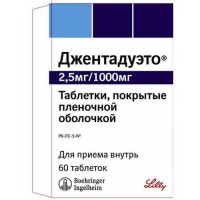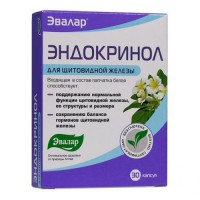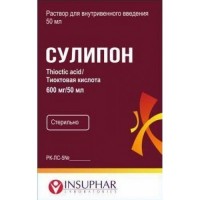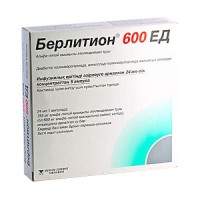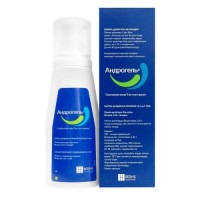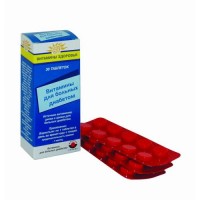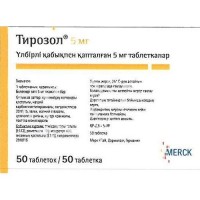Dialipon (ALA) 3% 10 ml (5 vials)
- $18.10
Structure
1 ml of the solution contains the active substance - the meglumine salt of alpha-lipoic acid 58.382 mg, which corresponds to 30 mg of alpha-lipoic acid in terms of 100% substance;
excipients: meglumine (N-methylglucamine), polyethylene glycol 300 (macrogol 300), water for injection
Alpha-lipoic acid (ALA) is a possible alternative remedy to treat the pain associated with diabetic polyneuropathy. Neuropathy, or nerve damage, is a common and potentially serious complication of diabetes. Nerve damage is permanent, and its symptoms can be difficult to alleviate. Polyneuropathy involves the peripheral nerves of the body. It’s the most common form of neuropathy in people who have diabetes, and it causes foot and leg pain.
Several studies suggest alpha-lipoic acid helps lower blood sugar levels. Its ability to kill free radicals may help people with diabetic peripheral neuropathy, who have pain, burning, itching, tingling, and numbness in arms and legs from nerve damage. Researchers believe Alpha-lipoic acid helps improve insulin sensitivity.
Indications for use
- diabetic polyneuropathy
Method of administration and dosage
The drug is prescribed for intravenous injections / infusions after preliminary dilution in 0.9% sodium chloride solution.
In severe diabetic polyneuropathy, treatment of adults begins with the infusion of 20 ml of a solution (600 mg of α-lipoic acid) diluted in 250 ml of 0.9% sodium chloride solution, once a day. Enter slowly - no more than 50 mg of α-lipoic acid (1.7 ml of solution for infusion) per minute. In very severe cases, the daily dose is increased to 900-1200 mg / day.
The initial course of treatment is carried out for 2-4 weeks. Subsequently, they switch to maintenance therapy with oral dosage forms of α-lipoic acid (Dialipon® capsules) at a dose of 600 mg 1-3 times a day for 1 to 3 months.
For the prevention of diabetic polyneuropathy, the dose of the drug is set individually, depending on the age, body weight of the patient and the severity of the disease. It is necessary to start with an initial dose of 10 ml of solution (300 mg of α-lipoic acid) per day.
The course of Dialipon® therapy is recommended 2 times a year.
Side effects
Often:
- allergic reactions: urticaria, eczema, itching, dermatitis at the injection site, burning pain
Rarely:
- a feeling of heaviness in the head
- headache
- nausea
- vomiting
- increased intracranial pressure
- hot flashes
- difficulty breathing
Very rarely:
- anaphylactic shock
- convulsions
- diplopia
- petechial rash, thrombophlebitis
- dysfunction of platelets (thrombocytopathy, hypocoagulation, hemorrhagic rash (purpura)
- hypoglycemia (dizziness, increased sweating, headache, visual impairment)
- feeling of burning pain
- pain in the region of the heart
- tachycardia
With a quick intravenous injection, a feeling of heaviness in the head, increased intracranial pressure, hot flashes, sweating, nausea, vomiting, short-term retention or difficulty in breathing, which pass on their own, are possible.
Contraindications
- hypersensitivity to the drug or to one of its components
- children under 18 years old
- pregnancy and lactation
Drug interactions
Dialipon® reacts in vitro with ionic metal complexes (for example, with cisplatin), so the drug may reduce their effect. Dialipon® forms poorly soluble complex compounds with sugars. Because of this, the Dialipon® infusion solution is incompatible with glucose, fructose, Ringer solutions. The drug is incompatible with solutions containing compounds that react with SH-groups or disulfide bridges.
An increase in the hypoglycemic effect is possible when taking insulin or oral antihyperglycemic agents, therefore, constant monitoring of the glycemic level is necessary, especially at the beginning of treatment with Dialipon® and correction of doses of hypoglycemic agents.
Special instructions
In the treatment of diabetic patients, frequent glycemic control is required. In some cases, it is necessary to adjust the dose of antidiabetic drugs to prevent hypoglycemia.
During the treatment of polyneuropathy, due to the regeneration processes, a short-term increase in sensitivity is possible, which is accompanied by paresthesia with a feeling of "creeping".
Continuous alcohol consumption is a risk factor for the development of polyneuropathy and may reduce the effectiveness of Dialipon®. Therefore, it is recommended to refrain from drinking alcohol during drug treatment. You should not prescribe Dialipon® at the same time as drugs containing metals (iron preparations), magnesium and calcium.
The drug is photosensitive, therefore, the ampoules should be removed from the packaging only immediately before use.
Infusion solutions should be protected from sunlight by covering with light protective bags. Under these conditions, the prepared infusion solution remains suitable for no more than 6 hours.
Features of the effect of the drug on the ability to drive vehicles and potentially dangerous mechanisms
The drug does not affect the reaction rate when driving or working with other mechanisms, but in case of signs of side effects of the drug (see "Side Effects"), you must refrain from this type of activity.
Application during pregnancy or lactation
The drug Dialipon® is contraindicated for use during pregnancy. If necessary, its use during lactation should stop breastfeeding. In experimental studies on animals, no teratogenic effect of thioctic acid was detected. Similar studies have not been conducted in humans. There are no data on the excretion of thioctic acid in breast milk.
Overdose
Symptoms - nausea, vomiting, headache. In case of an overdose or suspicion of the development of serious side effects, it is necessary to immediately stop the injection and, without removing the injection needle, slowly infuse through it 0.9% sodium chloride solution.
There is evidence that as a result of the accidental or deliberate use of lipoic acid at a dose of 10-40 g against the background of alcohol intoxication, isolated cases were observed with serious signs of intoxication up to a fatal outcome. Clinical signs of intoxication were manifested in the form of psychomotor disturbance or fainting with subsequent generalized seizures and the development of lactic acidosis. Lipoic acid intoxication results in hypoglycemia, shock, rhabdomyolysis, hemolysis, disseminated intravascular coagulation, bone marrow suppression, and organ failure.
Treatment - in case of acute lipoic acid poisoning, immediate hospitalization is indicated with general therapeutic measures for detoxification of the body (artificial respiration, vomiting, gastric lavage, activated carbon, etc.). For the treatment of generalized seizures, lactic acidosis and other consequences of intoxication, one should be guided by the means of modern intensive therapy and a symptomatic approach to accelerate the excretion of lipoic acid. Further treatment is symptomatic.
Storage conditions
Store in its original packaging at a temperature not exceeding 25 ° C.
Keep out of the reach of children!
Shelf life - 5 years
Do not use the drug after the expiry date indicated on the package.

